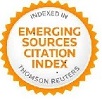The Third Sophistic. Theoretical Approaches to Historiography, Late Antiquity and Postmodernism
Keywords:
Rhetoric, Late Antiquity, Third SophisticAbstract
The study of Late Antiquity has generated an increasing interest not only within the realms of the Imperial Greek and Latin literature but also within the rhetorical milieu of the Roman Empire. In last decades, efforts have been made to try to categorize rhetorical works from the fourth to the sixth centuries under a unified term, namely “Third Sophistic”. The impact of such a denomination has led to the naming of several contemporary philosophical, historiographical and literary movements. The aim of this paper is to study, survey, and discuss in further detail these “Third Sophistics” that have appeared over the course of recent decades.
Downloads
References
AGUILAR GIMÉNEZ, A. (2004), Retórica y post-estructuralismo. Introducción a la materialidad del lenguaje en teoría de la literatura, Tesis doctoral, Valencia.
ANDO, C. (2009), “Narrating decline and fall”, A Companion to Late Antiquity, Oxford: Wiley-Blackwell, pp. 59-76.
BALLIF, M. (1998), “Writing the Third-Sophistic Cyborg: Periphrasis on an [In]Tense Rhetoric”, Rhetoric Society Quarterly 28:4, 51-72.
BALLIF, M. y MORAN, M. G. (eds.) (2005), Classical Rhetorics and rhetoricians: critical studies and sources, Greenwood: Greenwood Press.
BARNES, T. D. (1971), Tertullian. A historical and literary study, Oxford: Oxford University Press.
BLOCH, M. (1975), “Why Oratory?”, Political language and oratory in traditional society, Londres: Academic Press.
BROWN, P. (1992), Power and Persuasion in Late Antiquity, Madison: University of Wisconsin Press.
BRUNT, P. A. (1994), “The Bubble of the Second Sophistic”, BICS 39, 25-52.
CAMERON, AL. (1999), “The last pagans of Rome”, The Transformations of Vrbs Roma in Late Antiquity, Portsmouth: Journal of Roman archaeology. Supplementary series 33, pp. 109-121.
CAMERON, AV. (2002), “The long Late Antiquity: a late twentieth-century model”, Classics in Progress. Essays on Anciete Greece and Rome, Oxford: University Press, pp. 165-191.
____ (2006) “New Themes and Styles in Greek Literature, A title revisited”, Greek Literature in Late Antiquity. Dynamism, Didacticism, Classicism, Harvard: Ashgate, pp. 11-27.
DUARTE, D. (2004), Electronic Writing Technologies and the Third Sophistic, Unpublished PhD, Texas.
EASTERLING, P. y HALL, E. (eds.) (2002), Greek and Roman Actors. Aspects of an Ancient Profession, Cambridge: Cambridge University Press.
ELSNER, J. (2002), “The birth of Late Antiquity: Riegl and Strzygowski in 1901”, Art History 25.3, 358-379.
FORBES, C. (1986), “Comparison, self-praise and irony: Paul ́s boasting and the conventions of Hellenistic rhetoric”, NTS 32, 1-30.
GILDENHARD, I. y RUELH, M. (eds.) (2003), Out of Arcadia. Classics and Politics in Germany in the Age of Burckhardt, Nietzsche and Wilamowitz, Londres: Institute of Classical Studies.
GLEASON, M. (1995), Makingmen. Sophists and self-presentation in Ancient Rome, Princeton: University Press.
GÜTHENKE, C (2009), “Shop Talk. Reception Studies and recent work in the history of scholarship”, Classical Receptions Journal 1:1, 104-115.
HOMES DUCEN, F. (1935), The life and time of St. Ambrose, Oxford: Clarendon Press.
KALDELLIS, A. (2007), Hellenism in Byzantium: The Transformations of Greek Identity and the Reception of the Classical Tradition, Cambridge: University Press.
KENNEDY, G. (2003), “Some recent controversies in the Study of Later Greek Rhetoric”, AJPh 124.2, 295-301.
KERFERD, G. B. (1981), “The future direction of Sophistic Studies”, The Sophists and their Legacy, Wiesbaden: Steiner.
LUGARESI, L. (2008), Il teatro di Dio : il problema degli spettacoli nel cristianesimo antico (II-IV secolo), Brescia: Morcelliana.
MACCORMACK, S. (1981), Art and Ceremony in Late Antiquity, Berkeley-Londres: University of California Press.
MALOSSE, P. L. y SCHOULER, B. (2009), “Qu ́est-ce que la troisieme sophistique”, Lalies 29, 161-224.
MARCHAND, S. (1996), Down from Olympus. Archaeology and Phillohelenism in Germany (1750-1970), Princeton: University Press.
MARCONE, A. (2008), “A Long Late Antiquity? Considerations on a Controversial Periodization”, Journal of Late Antiquity 1:1, 4-19.
MILAZZO, A. (2000), Un dialogo difficile: la retorica in conflitto nei Discorsi Platonici di Elio Aristide, Olms: Neuware.
MURPHY, J. J. (1974), Rhetoric in the Middle Ages. A History of Rhetorical Theory from Saint Augustine to the Renaissance, Londres-Berkeley: University of California Press.
PERNOT, L. (1993), La rhétorique de l ́éloge dans le monde Greco-Romainm París: Institut d ́études Augustinnienes.
____(1998), “La rhétorique de l ́Empire ou comment la rhétorique grecque a inventé l ́Empire romain”, Rhetorica 16: 2, 131-148.
____(2000) La rhétorique dans l ́Antiquité, París : Librairie Générale Française.
____(2006) “La Seconde Sophistique et l ́Antiquité Tardive”, Classica 19:1, 30-44.
POULAKOS, J. (1990), “Interpreting Sophistical Rhetoric: a response to Schiappa”, Rhetoric and Philosophy 23:4, 218-228.
____(2007), “Modern Interpretations of Classical Greek Rhetoric”, ACompanion to Greek Rhetoric, Oxford: Blackwell, pp. 16-26.
PUECH, B. (2002), Orateurs et sophistes grecs dans les inscriptions d ́époque impériale, París: Librairie Philosophique.
REARDON, B. P. (1971), Courants litteraires grecs des II et III siécles après J.-C., París: Les Belles Lettres.
SAID, E. (1978), Orientalism, Nueva York: Pantheon.
SCHAMP, J. (2006), Sophistes à l ́ambon. Esquisses pour la Troisième Sophistique comme paysage littéraire, en Approches de la Troisième Sophistique. Hommage à Jaques Schamp, Bruselas: Coll. Latomus, pp. 286-338.
SCHIAPPA, E. (1990) “”Neo-Sophistic Rhetorical Criticism or the Historical Reconstruction of Sophistic Doctrines?”, Rhetoric and Philosophy 23:3, 192-217.
SCHOULER, B. (1977), La tradition hellenique chez Libanios, Lille : Les Belles Lettres.
VITANZA, V. (1991), “Some more notes, toward a Third Sophistic”, Argumentation 5, 117-139.
WARD-PERKINS, B. (2007), La caída de Roma y el fin de la civilización, Madrid: Espasa.
WATTS, E. J. (2006), City and School in Late Antique Athens and Alexandria, Berkeley: University of California Press.
WENDLAND, E. R. (2002), “Aspects of Rhetorical Analysis applied to New Testament texts”, Handbook of Early Christianity. Social Science Approaches, Boston-Oxford: Altamira Press, pp. 169-195.
WHITMARSH, T. (2005), The Second Sophistic, Oxford: University Press.
WINTER, B. (1997), Philo and Paul among the Sophists, Cambridge: Eerdmans












